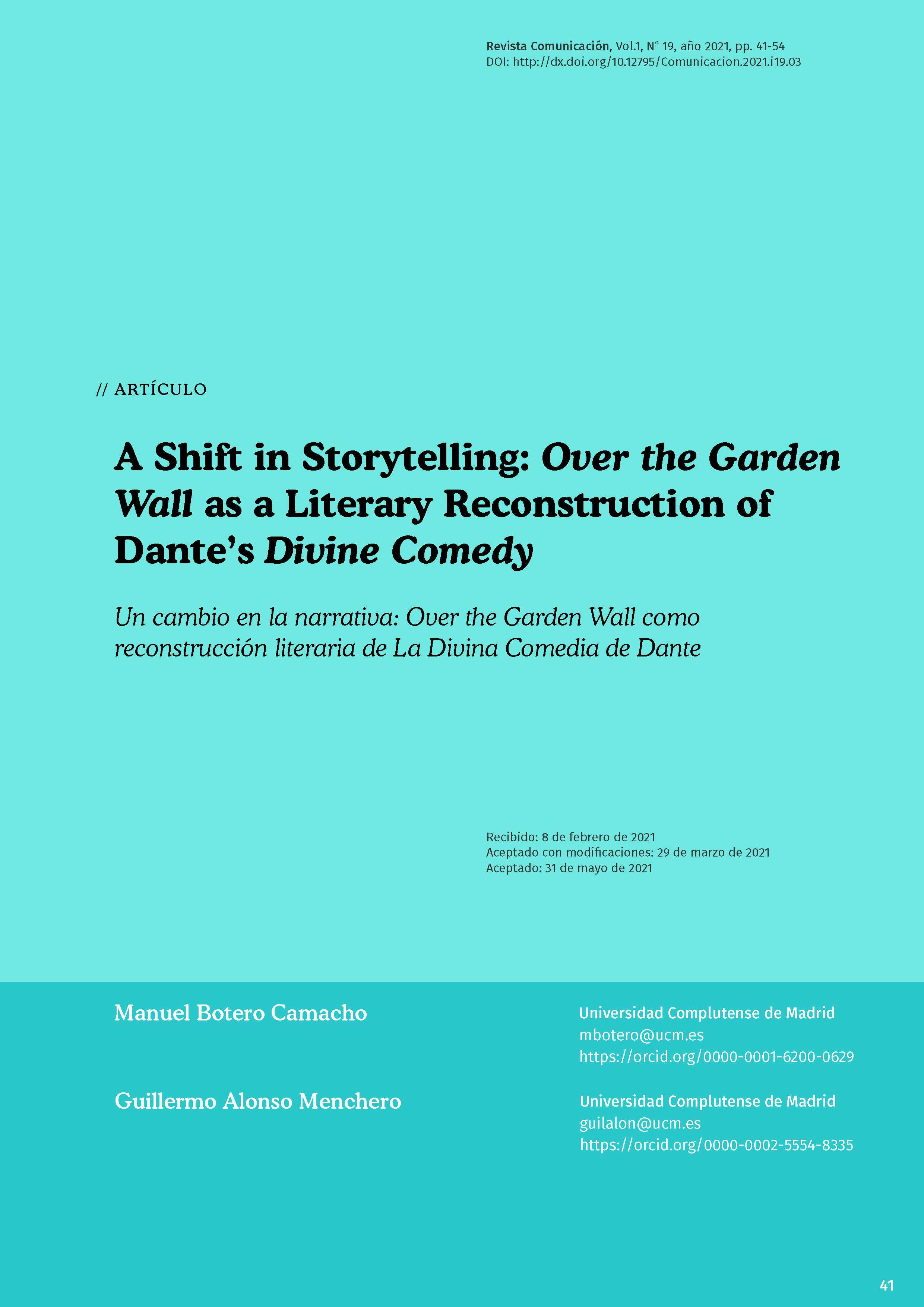Abstract
Literature remains a field that serves TV creators and critics as a model both for influence and comparison. The continuity claimed by Thomas Doherty between the most recent TV narrative form with the serialised novels of Dickens or Wharton is not limited to the form itself but to its content as well. Such is the case of the TV miniseries Over the Garden Wall, created by Patrick McHale in 2014, whose combination of Victorian fairy-tale imagery and aesthetics,as well as its reliance on literary allusion incarnates this paradigm. Within its narrative there can be found an array of literary references that range from the classics to children’s fables, as well as allusions to history and to different mythologies; an intertextual character that is featured in TV as much as in literary texts from all eras, binding the two forms together. Among the numerous texts referenced in this tale of tales, however, there is one that stands out: Dante Alighieri’s Divine Comedy.This article scrutinises suchrelationship. The main claim is that by doing so, the show highlights how Campbell’s narrative paradigm, applicable to forms of media other than literature, evinces the narrative continuity, which exists between TV and the written text.
References
Alighieri, Dante, David H. Higgins (ed.) (2008). Divine Comedy. Traducción de Charles H. Sisson. Oxford: Oxford UP.
Avery, William T (1974-1975). Elementos Dantescos del Quijote. Anales cervantinos 13-14 : 3–36.
Bloom, Harold (1994). The Western Canon: The Books and Schools of the Ages. New York: Harcourt Brace.
Bourdieu, Pierre (1994). On Television. Traducción de Priscilla Parkbust Ferbuson. New York: The New Press.
Campbell, Joseph (2004). The Hero with a Thousand Faces. Commemorative Edition. Princeton: Princeton UP.
Cardwell, Sarah, Jacobs Jason, y Peacock Steven (eds.) (2013). Television Aesthetics: Stylistic Analysis and Beyond. Television Aesthetics and Style (pp. 23-44). London: Bloomsbury
De Rougemont, Denis (1983). Love in the Western World. Traducción de Montgomery Belgion. Princeton: Princeton UP.
Doherty, Thomas (2012). “Storied TV: Cable Is the New Novel” The Chronicle of Higher
Education. Chronicle. Recuperado de https://www.chronicle.com/article/Cable-Is-the-New-Novel/134420.
Eliot, T. S (1991). Dante. Selected Essays (pp. 237–277). London: Faber & Faber.
Genette, Gérard (1997). Palimpsests: Literature in the Second Degree. Traducción de Channa Newman y Claude Doubinsky. London: University of Nebraska Press.
Huyssen, Andreas (1986). After the Great Divide: Modernism, Mass Culture, Postmodernism. Indianapolis: Indiana UP.
Kozloff, Sarah y Allen, Robert (ed.) (1992). “Narrative Theory and Television” Channels of Discourse, Reassembled: Television and Contemporary Criticism. The University of North Carolina Press.
Kristeva, Julia, y Toril Moi (1986). The Kristeva Reader. New York: Columbia UP.
Madariaga, Salvador de (1972). Guía del lector del Quijote. Buenos Aires: Editorial Sudamericana.
Mchale, Patrick (2013). Tome of the Unknown: Harvest Melody. Cartoon Network Studios.
Mchale, Patrick (2014). Over the Garden Wall. Cartoon Network Studios.
Mendible, Myra (1999). High Theory/Low Culture. Postmodernism and the Politics of Carnival. Journal of American Culture, 2, 71-76.
Mittel, Jason (2006). Narrative Complexity in Contemporary American Television. The Velvet Light Trap, 58, 29-40.
Trey the Explainer (9.11.2015). Over the Garden Wall is Dante’s Inferno (Symbolism Analysis). YouTube. Recuperado de https://www.youtube.com/watch?v=MBg8tQvATIA

This work is licensed under a Creative Commons Attribution-NonCommercial-ShareAlike 4.0 International License.
Copyright (c) 2021 Manuel Botero Camacho y Guillermo Alonso Menchero


